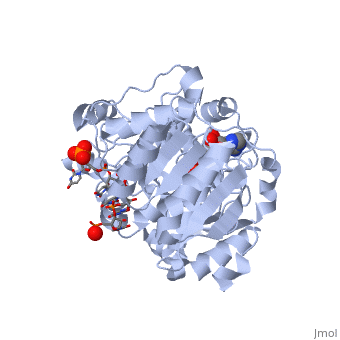2db3: Difference between revisions
No edit summary |
No edit summary |
||
| Line 1: | Line 1: | ||
[[Image: | ==Structural basis for RNA unwinding by the DEAD-box protein Drosophila Vasa== | ||
<StructureSection load='2db3' size='340' side='right' caption='[[2db3]], [[Resolution|resolution]] 2.20Å' scene=''> | |||
== Structural highlights == | |||
<table><tr><td colspan='2'>[[2db3]] is a 8 chain structure with sequence from [http://en.wikipedia.org/wiki/Drosophila_melanogaster Drosophila melanogaster]. Full crystallographic information is available from [http://oca.weizmann.ac.il/oca-bin/ocashort?id=2DB3 OCA]. For a <b>guided tour on the structure components</b> use [http://oca.weizmann.ac.il/oca-docs/fgij/fg.htm?mol=2DB3 FirstGlance]. <br> | |||
</td></tr><tr><td class="sblockLbl"><b>[[Ligand|Ligands:]]</b></td><td class="sblockDat"><scene name='pdbligand=ANP:PHOSPHOAMINOPHOSPHONIC+ACID-ADENYLATE+ESTER'>ANP</scene>, <scene name='pdbligand=MG:MAGNESIUM+ION'>MG</scene><br> | |||
<tr><td class="sblockLbl"><b>[[Gene|Gene:]]</b></td><td class="sblockDat">VASA ([http://www.ncbi.nlm.nih.gov/Taxonomy/Browser/wwwtax.cgi?mode=Info&srchmode=5&id=7227 Drosophila melanogaster])</td></tr> | |||
<tr><td class="sblockLbl"><b>Activity:</b></td><td class="sblockDat"><span class='plainlinks'>[http://en.wikipedia.org/wiki/Adenosinetriphosphatase Adenosinetriphosphatase], with EC number [http://www.brenda-enzymes.info/php/result_flat.php4?ecno=3.6.1.3 3.6.1.3] </span></td></tr> | |||
<tr><td class="sblockLbl"><b>Resources:</b></td><td class="sblockDat"><span class='plainlinks'>[http://oca.weizmann.ac.il/oca-docs/fgij/fg.htm?mol=2db3 FirstGlance], [http://oca.weizmann.ac.il/oca-bin/ocaids?id=2db3 OCA], [http://www.rcsb.org/pdb/explore.do?structureId=2db3 RCSB], [http://www.ebi.ac.uk/pdbsum/2db3 PDBsum], [http://www.topsan.org/Proteins/RSGI/2db3 TOPSAN]</span></td></tr> | |||
<table> | |||
== Evolutionary Conservation == | |||
[[Image:Consurf_key_small.gif|200px|right]] | |||
Check<jmol> | |||
<jmolCheckbox> | |||
<scriptWhenChecked>select protein; define ~consurf_to_do selected; consurf_initial_scene = true; script "/wiki/ConSurf/db/2db3_consurf.spt"</scriptWhenChecked> | |||
<scriptWhenUnchecked>script /wiki/extensions/Proteopedia/spt/initialview01.spt</scriptWhenUnchecked> | |||
<text>to colour the structure by Evolutionary Conservation</text> | |||
</jmolCheckbox> | |||
</jmol>, as determined by [http://consurfdb.tau.ac.il/ ConSurfDB]. You may read the [[Conservation%2C_Evolutionary|explanation]] of the method and the full data available from [http://bental.tau.ac.il/new_ConSurfDB/chain_selection.php?pdb_ID=2ata ConSurf]. | |||
<div style="clear:both"></div> | |||
<div style="background-color:#fffaf0;"> | |||
== Publication Abstract from PubMed == | |||
DEAD-box RNA helicases, which regulate various processes involving RNA, have two RecA-like domains as a catalytic core to alter higher-order RNA structures. We determined the 2.2 A resolution structure of the core of the Drosophila DEAD-box protein Vasa in complex with a single-stranded RNA and an ATP analog. The ATP analog intensively interacts with both of the domains, thereby bringing them into the closed form, with many interdomain interactions of conserved residues. The bound RNA is sharply bent, avoiding a clash with a conserved alpha helix in the N-terminal domain. This "wedge" helix should disrupt base pairs by bending one of the strands when a duplex is bound. Mutational analyses indicated that the interdomain interactions couple ATP hydrolysis to RNA unwinding, probably through fine positioning of the duplex relative to the wedge helix. This mechanism, which differs from those for canonical translocating helicases, may enable the targeted modulation of intricate RNA structures. | |||
Structural basis for RNA unwinding by the DEAD-box protein Drosophila Vasa.,Sengoku T, Nureki O, Nakamura A, Kobayashi S, Yokoyama S Cell. 2006 Apr 21;125(2):287-300. PMID:16630817<ref>PMID:16630817</ref> | |||
From MEDLINE®/PubMed®, a database of the U.S. National Library of Medicine.<br> | |||
</div> | |||
==See Also== | ==See Also== | ||
*[[Helicase|Helicase]] | *[[Helicase|Helicase]] | ||
== References == | |||
== | <references/> | ||
< | __TOC__ | ||
</StructureSection> | |||
[[Category: Adenosinetriphosphatase]] | [[Category: Adenosinetriphosphatase]] | ||
[[Category: Drosophila melanogaster]] | [[Category: Drosophila melanogaster]] | ||
Revision as of 05:32, 29 September 2014
Structural basis for RNA unwinding by the DEAD-box protein Drosophila VasaStructural basis for RNA unwinding by the DEAD-box protein Drosophila Vasa
Structural highlights
Evolutionary Conservation Check, as determined by ConSurfDB. You may read the explanation of the method and the full data available from ConSurf. Publication Abstract from PubMedDEAD-box RNA helicases, which regulate various processes involving RNA, have two RecA-like domains as a catalytic core to alter higher-order RNA structures. We determined the 2.2 A resolution structure of the core of the Drosophila DEAD-box protein Vasa in complex with a single-stranded RNA and an ATP analog. The ATP analog intensively interacts with both of the domains, thereby bringing them into the closed form, with many interdomain interactions of conserved residues. The bound RNA is sharply bent, avoiding a clash with a conserved alpha helix in the N-terminal domain. This "wedge" helix should disrupt base pairs by bending one of the strands when a duplex is bound. Mutational analyses indicated that the interdomain interactions couple ATP hydrolysis to RNA unwinding, probably through fine positioning of the duplex relative to the wedge helix. This mechanism, which differs from those for canonical translocating helicases, may enable the targeted modulation of intricate RNA structures. Structural basis for RNA unwinding by the DEAD-box protein Drosophila Vasa.,Sengoku T, Nureki O, Nakamura A, Kobayashi S, Yokoyama S Cell. 2006 Apr 21;125(2):287-300. PMID:16630817[1] From MEDLINE®/PubMed®, a database of the U.S. National Library of Medicine. See AlsoReferences
|
| ||||||||||||||||||||
